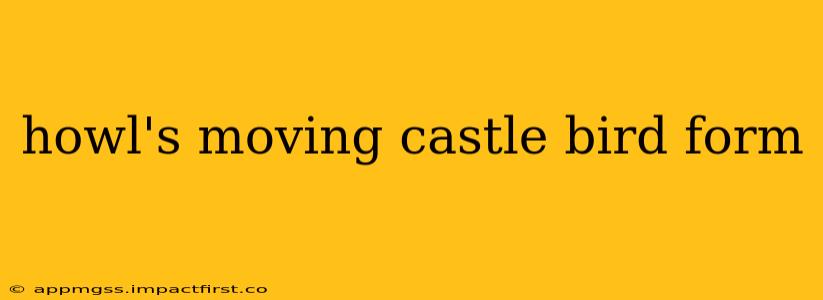Howl Pendragon, the charismatic and powerful wizard from Studio Ghibli's masterpiece Howl's Moving Castle, possesses a unique and captivating ability: transforming into a magnificent, black bird. This striking form plays a crucial role in the narrative, adding layers of mystery and symbolism to the already enchanting story. This article explores the details of Howl's bird form, delving into its significance and addressing some frequently asked questions.
What Kind of Bird is Howl When He Transforms?
While Miyazaki doesn't explicitly state the species, Howl's bird form is widely interpreted as a large, black bird of prey, possibly a raven or a similar species. Its sleek, dark feathers, powerful wings, and overall majestic appearance evoke a sense of power and freedom. The specific species remains open to interpretation, adding to the mystical allure of the transformation. The focus isn't on precise ornithological classification but rather on the visual representation of Howl's magical power and his emotional state.
Why Does Howl Turn into a Bird?
Howl's transformation isn't a simple flick of a switch; it's deeply connected to his emotional state and his magical abilities. Several factors trigger his transformation:
- Escape: Often, Howl transforms into a bird to escape danger or unwanted attention. His bird form allows him to flee quickly and discreetly, utilizing his powerful wings to navigate even challenging terrain.
- Emotional Distress: Transformation can also serve as a coping mechanism for Howl's emotional turmoil. The bird form offers a temporary respite from the pressures and conflicts that constantly plague him. This reflects Howl's complex personality and his struggle to maintain control over his emotions and his powers.
- Magical Manifestation: The transformation itself is a testament to Howl's immense magical abilities. It's a visible demonstration of his control over his powers, albeit one that sometimes escapes his full control.
How Does Howl Transform?
The exact mechanics of Howl's transformation are never fully explained, adding to its mystique. It appears to be an instantaneous process, initiated by his will and facilitated by his powerful magic. We see a shimmering, almost ephemeral quality to the transformation, reinforcing the idea that this is a magical act rather than a biological one.
What Does Howl's Bird Form Symbolize?
Howl's bird form is rich with symbolic meaning:
- Freedom: The ability to take to the skies represents freedom from constraints and responsibilities. It symbolizes Howl's desire to escape his burdens and find solace in the open air.
- Transformation & Metamorphosis: The transformation itself underscores the themes of change and metamorphosis that are central to the film's narrative. Howl's journey mirrors the process of transformation, both physically and emotionally.
- Escape from Responsibility: In some interpretations, the bird form can symbolize Howl's avoidance of his responsibilities and his tendency to run away from his problems.
Is Howl's Bird Form Connected to Calcifer?
While not explicitly stated, it's plausible that Howl's connection with Calcifer, the fire demon bound to him, plays a role in his ability to transform. Calcifer's magical energy might be a necessary component of Howl's transformations, though this remains a matter of speculation and interpretation based on the film's narrative.
Conclusion
Howl's moving castle bird form is more than just a visually striking element; it’s a crucial aspect of his character, magic, and the film's overarching themes. It represents freedom, transformation, escape, and the complexities of his personality. While some aspects remain shrouded in mystery, the unanswered questions only enhance its allure and contribute to the film's enduring appeal. The beauty of Howl's bird form lies in its ambiguity, allowing audiences to engage with the symbolism and draw their own conclusions.
